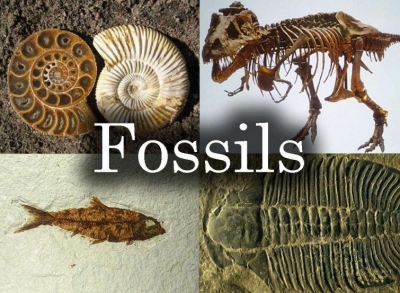
FOSSILS
The remains, impressions, or traces of organisms (such as plants and animals) that have been preserved in the rocks are known as fossils. The process of fossilization generally takes millions of years, and as special circumstances are needed for fossils to form, only a tiny proportion of Earth’s organisms have been fossilized. It is not always easy to date fossils absolutely, so the palaeontologists who find, analyze, and identify fossils usually assign them to named eras and periods. These cover the major phases in the long history of life on Earth.
PALAEOZOIC ERA (ANCIENT LIFE)
Life began in the Precambrian era, more than 3.5 billion years ago, but for most of that time life was restricted to single-celled organisms like bacteria. The start of the Palaeozoic era 540 million years ago saw an explosion of multicellular life, such as marine arthropods, molluscs, and primitive relatives of fish.
MESOZOIC ERA (MIDDLE LIFE)
Beginning 252 million years ago, this was the age of the dinosaurs, when giant reptiles stalked the land, pterosaurs swooped through the skies, and marine reptiles such as ichthyosaurs swam alongside squid-like ammonites. Flowering plants and small mammals also appeared on land. The era ended with a mass extinction 66 million years ago.
CENOZOIC ERA (RECENT LIFE)
Non-bird dinosaur fossils do not appear in rock formed less than 66 million years ago in the Cenozoic era, showing that they had died out by that time. Yet mammal fossils become more varied, and include early relatives of humans, which date back to 6-7 million years ago. The first true humans appeared about a million years later.
PALAEONTOLOGY
The word “palaeontology” means the study of ancient life, preserved as fossils. But palaeontologists also study non-bony life forms such as molluscs, plants, and even bacteria. Their work involves carefully removing, cleaning, and preserving the fossils, as well as identifying them and recording their features. Special tools ranging from hammers to medical scanners help them prepare and interpret their finds.
FOSSILIZATION
Normally only the hard parts of living things, such as shells and bones, survive as fossils. Over millions of years these become impregnated with minerals, so they become stony. Often the original shell or bones disappear, leaving a mould later filled by another mineral. Rarely, soft body parts such as feathers may leave detailed impressions in fine-grained rock.
Picture Credit : Google



